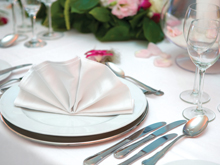Health Topics
-
Healthy Living
-
|
August 2011 |
In the Face of Knives & Forks
Fine Dining Etiquette |
| Moushumi Gupta |
|
 |
Ever been faced with a battalion of knives and forks and wondered what to do with them? Where does the napkin go when you get up in the middle of your meal? Do you break the bread or cut it? |
Welcome to the world of fine dining etiquette! Â Here you are expected to follow a set of rules while dining in a formal setup. Good manners, appropriate posture, conversation skills, coupled with poise and confidence are the basic aspects of fine dining.
Fine dining has undergone a lot of change over the years. Gone are the days of  the ornate table settings difficult to manoeuvre through. Minimalistic and user friendly table settings are the call of the hour. However, acquaint yourself with the basic rules and expectations of fine dining etiquette
Place settings
- A general knowledge of the placement of dishes, glasses and flatware will aide you in knowing what pieces are yours.
- The main dish will be directly in front of you, central to your body.
- All the drinks will be placed to the upper right hand corner of your plate.
- The bread plate will be at your left.
- The forks will be located to the left of your plate and the knife, directly right to your plate with the blade facing inwards, followed by spoons.
- Sometimes the dessert utensils will be placed horizontally just north of your plate, but it is becoming more common for them to be brought out with the dessert when needed.
- When choosing which utensil to use for which course, you should start with the outermost utensil and move inwards.
- Glasses are placed on the right upper side of your plate. You can have up to four glasses at a formal setting. The top left glass is for red wine and it usually has a fairly large bowl followed by the white wine glass which is smaller in size. At the top right corner is the champagne glass or perhaps a smaller glass for dessert wines or port and on the bottom right is the water glass.
- To indicate that you have not finished with your meal, place the cutlery on your plate with the tips crossing each other.
- When you are finished, place your knife and fork together in the centre of the plate vertically. The tines of the fork should point up and the blade of the knife should point to the centre towards the fork.
How to handle your flatware
-
The American Style --The Zig Zag Method: By American custom, all three utensils are intended for use primarily with the right hand, which is the more capable hand for most people. This leads to some complicated manoeuvring when foods, such as meat, require the use of knife and fork to obtain a bite of manageable size.
- European Style: The European, or Continental, style of using knife and fork is somewhat more efficient, and is less complicated as the fork stays in the left hand and the knife in the right.
Some Handy Tips
- Proper posture at the table is very important. Â Sit up relatively straight in your chair; do not hunch forward, and do not slouch back. Refrain from resting your elbows on the table.
- As soon as you are seated, remove the napkin from your place setting, unfold it, and put it on your lap. If you must leave the table before you have finished, you should place your napkin on your seat. Never wipe your mouth with a napkin, always dab.
- Dip the spoon into the soup, moving it away from the body, until it is about two-thirds full, then sip the liquid (without slurping) from the side of the spoon (without inserting the whole bowl of the spoon into the mouth). When you finish, place the spoon on the service plate of the soup bowl.
- It is improper to cut yourself a slice of bread with a knife. Instead, you should tear off a slice with your hands.
|
|
 |
Moushumi Gupta is Corporate Trainer for Soft Skills |
|
|